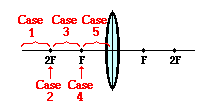2 types of lenses:
- Concave (Diverging)
- Convex (Converging)
For this chapter, it places more emphasis on converging lens rather than diverging lens.
First and foremost, let us recap the difference between a virtual image and a real image.
Virtual Image:
- Cannot be capture on the screen (Reason: No actual light rays converge at the image position)
Real Image:
- Can be captured on the screen. (Reason: Actual light rays meet at the image position)
Note: For every object point, we obtain a corresponding image point.
--
The focal point of the lens is dependent on its curvature.
--
TERMINOLOGY
Optical centre: Point at centre of lens
Principal axis: Line passing symmetrically through optical centre of lens
Principal focus: Point where all rays close to or parallel to the principal axis converge after refraction by the lens.
Focal length is the distance between the optical centre of the lens and the principal focus
Focal plane: Plane passing through F and perpendicular to the principal axis
--------
PRINCIPAL RAYS
PATH 1: Incident ray through the optical centre without refraction
PATH 2: Incident ray parallel to principal axis is refracted to pass through the focal point, F.
PATH 3: Incident ray through the focal point, F is refracted to pass parallel to principal axis.
-----
5 cases:
Properties:
Diminished: Case 1
Same size: Case 2
Magnified: Case 3,4,5
Real: Case 1, 2, 3
Virtual: Case 4,5
Laterally inverted: Case 1, 2, 3
non-laterally inverted: Case 4,5
Inverted: Case 1, 2, 3
Upright: Case 4,5
----------------
Chapter 5.2 Colours of Light
Dispersion of light:
It refers to the process of separating white light into its constituent colors (Red, Orange, Yellow, Green, Blue, Indigo and Violet).
Visible spectrum of light:
(Red, Orange, Yellow, Green, Blue, Indigo and Violet).
Each coloured light has its unique wave length as shown above.
Note: Wavelength refers to the distance between two consecutive crests or troughs of a wave.
Summary:
Red light--> Longest wavelength among the 7 colors of light
Violet light--> Shortest wavelength among the 7 colors of light
-----
Addition of colours
Primary Colours
RED, GREEN, BLUE
Secondary Colours
YELLOW, CYAN, MAGENTA
Important: The mixing of colours of light is different from that of paints, inks or dyes.
-----------
Subtraction of colours
When light is shone on transparent materials, such as filters, they absorb their complementary colours and transmit the colour of the filter which they did not absorb.
When light is shone on opaque materials, such as cars, they absorb their complementary colours and reflect the colour of the car which they did not absorb.
---------------------------------------------------------------------------------


No comments:
Post a Comment